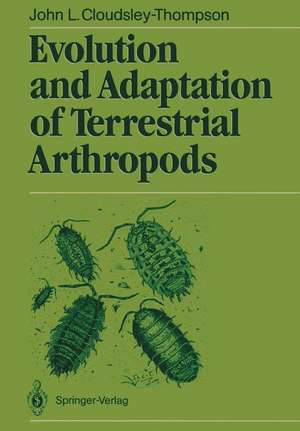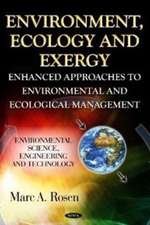Evolution and Adaptation of Terrestrial Arthropods
Autor John L. Cloudsley-Thompsonen Limba Engleză Paperback – 7 apr 1988
Preț: 634.49 lei
Preț vechi: 746.47 lei
-15% Nou
Puncte Express: 952
Preț estimativ în valută:
121.41€ • 129.83$ • 101.23£
121.41€ • 129.83$ • 101.23£
Carte tipărită la comandă
Livrare economică 17 aprilie-01 mai
Preluare comenzi: 021 569.72.76
Specificații
ISBN-13: 9783540181880
ISBN-10: 3540181881
Pagini: 152
Ilustrații: X, 141 p. 33 illus.
Dimensiuni: 170 x 244 x 8 mm
Greutate: 0.25 kg
Editura: Springer Berlin, Heidelberg
Colecția Springer
Locul publicării:Berlin, Heidelberg, Germany
ISBN-10: 3540181881
Pagini: 152
Ilustrații: X, 141 p. 33 illus.
Dimensiuni: 170 x 244 x 8 mm
Greutate: 0.25 kg
Editura: Springer Berlin, Heidelberg
Colecția Springer
Locul publicării:Berlin, Heidelberg, Germany
Public țintă
ResearchCuprins
1 Palaeontology and Phytogeny.- 1.1 The Earliest Arthropodan Fossils.- 1.2 The First Terrestrial Arthropods.- 1.3 Evolution in the Arthropods.- Further Reading.- 2 Implications of Live on Land.- 2.1 The Significance of Size.- 2.2 Water Relations.- 2.3 The Conquest of the Land.- 2.4 The Integument.- 2.5 Growth and Ecdysis.- 2.6 Respiration: Lung-Books and Tracheae.- 2.7 Nutrition and Excretion.- 2.8 Ecological Considerations of Size.- Further Reading.- 3 The Conquest of the Land by Crustacea.- 3.1 Types of Adaptation.- 3.2 Transition from Water to Land in Amphipoda.- 3.3 Transition from Water to Land in Decapoda.- 3.4 Transition from Water to Land in Isopoda.- 3.5 Conclusion.- Further Reading.- 4 Insect Phytogeny and the Origin of Flight.- 4.1 Ancestry of Insects.- 4.2 The Origin of Wings.- 4.3 Paranoial Theory.- 4.4 Tracheal Gill Theory.- 4.5 Selection for Flight.- 4.6 Phytogeny of the Lower Insect Orders.- 4.7 Wing Venation.- 4.8 The ‘Panorpoid Complex’.- 4.9 Insect Flight.- Further Reading.- 5 Evolutionary Trends in Reproduction.- 5.1 Spermatophores and Their Phylogenetic Significance.- 5.2 Functions of Aggregation and Courtship.- 5.3 Indirect Spermatophore Transfer via the Substrate.- 5.4 Indirect Sperm Transfer.- 5.5 Direct Copulation with Free Sperm.- 5.6 Haemocoelic Insemination.- 5.7 Conclusion.- Further Reading.- 6 Adaptations to Extreme Environments.- 6.1 Desert Adaptations.- 6.2 Forest Adaptations.- 6.3 Arctic and Alpine Adaptations.- 6.4 Littoral and Aquatic Adaptations.- 6.5 Cavernicolous Adaptations.- 6.6 Suspended Animation.- Further Reading.- 7 Dispersal and Migration.- 7.1 Migration in Relation to Habitat.- 7.2 Migration in Relation to Population Dynamics.- 7.3 Migration Without Flight.- 7.4 Meteorological Aspects of Air-Born Insect Migration.- 7.5Orientation During Migration.- 7.6 Migration and Diapause.- Further Reading.- 8 Defensive Mechanisms.- 8.1 Concealment from Vertebrate Predators.- 8.2 Advertisement with Respect to Vertebrate Predators.- 8.3 Chemical Defences.- 8.4 Defences Against Small Invertebrate Enemies.- 8.5 Avoidance of Parasites.- Further Reading.- 9 The Success of Terrestrial Arthropods.- 9.1 Criteria of Success.- 9.2 Reasons for Success.- 9.3 Adaptability.- 9.4 Conclusion.- Further Reading.














